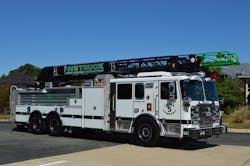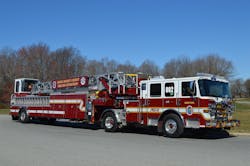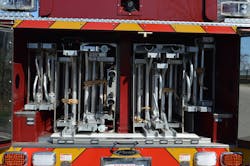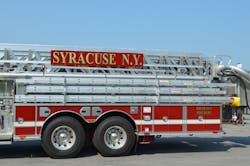The Apparatus Architect: The Ground Ladders that Your Rigs Must Carry
Let’s say that your department’s apparatus fleet plan this year calls for the replacement of Truck 4, which is a 2005 100-foot quint rear-mount ladder, with a new rig. Truck 4 is equipped with 158 feet of portable ground ladders, including two 35-foot, three-section extension ladders and several 16-foot roof ladders. While the apparatus committee is meeting with prospective bidders, one of the salespeople mentions that NFPA 1900: Standard for Aircraft Rescue and Firefighting Vehicles, Automotive Fire Apparatus, Wildland Fire Apparatus, and Automotive Ambulances, which took effect on Jan. 1, 2024, no longer requires ground ladders and that it now is up to the authority having jurisdiction to identify what ground ladders are needed on the vehicle. This causes some concern for the members of the apparatus committee as they begin their discussions regarding what length and style of ground ladders should be carried on the new ladder truck. (Note: Although some of the members of the apparatus committee indicate that a 500-gallon booster tank is a feature that would be nice to have on the rig, it isn’t critical for the operations that the department carries out.)
A senior member of the department who is on the committee suggests a review of the first-due response area to evaluate the structural conditions. Although some fellow apparatus committee members believe that this is a waste of time, after a few weeks of touring around the response area and measuring some of the building heights, a number of concerns come to light. In the time that passed since Truck 4 was placed into service, several new townhouse complexes were built, and they are three stories in height on the A side but, because of terrain, are four or five stories high on the C side of the structure. In addition, some previously undeveloped farmland that’s in the response district was turned into a residential subdivision, including 5,000- and 6,000-sq.-ft. McMansions, but has limited access for any type of aerial device.
After considering the building and demographic changes to the response area, the committee decides to reevaluate the importance of ground ladders on the new apparatus. The former NFPA 1901: Standard for Automotive Fire Apparatus requirements for the ground ladder complement were for a total of 85 feet on a quint and 115 feet on a non-quint apparatus. That said, over the years, ground ladder complements have been reduced, as quint apparatus have become more commonplace, with the result being a limited number of ground ladders being carried on new vehicles.
The standard ground ladder array on many pumpers is a 14-foot roof ladder, a 24-foot extension ladder and a 10-foot folding ladder. In addition to the traditional mounting on the right side of the apparatus, ground ladders can be carried on a hydraulic rack or enclosed in the body or through the water tank. The hydraulic rack works well when there is no overall travel height concern. It permits longer ladders to be carried where a 28-foot extension and 16-foot roof ladder would enhance the ladder equipment.
Aerial ladders and towers commonly are designed with a fire pump, a booster tank and a hosebed for supply line. The hosebed may be located ahead of the aerial turntable or on the side of the body over the lower compartments. In either event, the quantity of ground ladders that you wish to carry on the apparatus is determined by the available space that’s under the turntable and outside of the body, based on the water tank size, the depth of the body compartments, the amount of supply line that’s carried and the location of other components, such as hydraulic oil reservoir and the water way piping.
The ground ladder banking on any aerial device can be determined in conjunction with the apparatus manufacturer’s body engineering group. Those people can provide suggestions to enable your apparatus committee to maximize the available space to carry portable ladders.
The Dunkirk, MD, Volunteer Fire Department operates a 2020 Seagrave 100-foot rear-mount aerial ladder that’s equipped with 273 feet of ground ladders, including two 35-foot, two 28-foot and two 24-foot extension ladders, which are side stacked on the right side of the body. The apparatus also is equipped with 14- and 16-foot roof ladders. Built on a 240-inch wheelbase, this apparatus was designed with an emphasis on equipment and ground ladder complement.
The Prince George’s County, MD, Fire/EMS Department recently placed into service two Pierce Enforcer 107-foot tractor-drawn aerial ladders that carry 377 feet of portable ground ladders. The ladder array that’s on the rig includes a 45-foot Bangor ladder, three 35-foot and two 28-foot extension ladders, and 14-, 16- and 20-foot roof ladders.
Chassis/body components
Ground ladder storage areas on aerial apparatus depend on the packaging of other chassis and body components. The banking arrangement of on-beam or flat positions also might be influenced based on the maximum travel height of the apparatus. When beginning the process of specifying a new apparatus, it always is a good idea to confirm the principal dimensions of the apparatus bays, including their ramp angles, and height restrictions of various sort that are in the response area.
The body design of the aerial device affects the amount of space that’s available for ground ladder storage. The location of a prepiped waterway has a dramatic effect on the space that’s under the turntable that can be used for ground ladder storage.
After your department conducts the ground ladder needs assessment of the response district, it might be beneficial to work with prospective manufacturers to determine up front whether their standard body configuration can accommodate the desired ladder complement. It might be necessary to utilize both rear-body and side-stacked ladder configurations to accommodate the ladder banking arrangement that’s required.
Member safety
When designing a new aerial device, careful consideration must be given to determining the appropriate number and configuration of portable ground ladders that will be carried on the rig. While operating on the fireground, the proper placement of ground ladders is of vital importance for the safety of personnel as well as of potential victims who are inside of the building.
About the Author

Tom Shand
TOM SHAND, who is a Firehouse contributing editor, is a 36-year veteran of the fire service. He works with Michael Wilbur at Emergency Vehicle Response, consulting on a variety of fire apparatus and fire department master-planning issues. Shand is a member of the Firehouse Hall of Fame.
Michael Wilbur
MICHAEL WILBUR, who is a Firehouse contributing editor, retired as a lieutenant in FDNY, where he was last assigned to Ladder Company 27 in the Bronx. He has served on FDNY's Apparatus Purchasing Committee and consults on a variety of apparatus-related issues around the country. Wilbur is a member of the Firehouse Hall of Fame. For further information, access his website at www.emergencyvehicleresponse.com.




